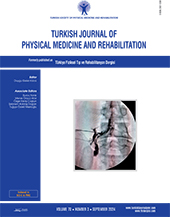The effect of osteoporosis education on osteoporosis knowledge level and daily life in Parkinson`s disease patients: A 12-week, randomized-controlled trial
2 Department of Physical Medicine and Rehabilitation, Dokuz Eylül University Faculty of Medicine, Izmir, Türkiye
3 Department of Neurology, Dokuz Eylül University Faculty of Medicine, Izmir, Türkiye
4 Public Health, Dokuz Eylül University Faculty of Medicinee, Izmir, Türkiye DOI : 10.5606/tftrd.2024.13026 Objectives: This study aims to evaluate the effect of osteoporosis education on osteoporosis knowledge level (OKL) and behavioral changes in daily life in patients with Parkinson`s disease (PD).
Patients and methods: Between May 2019 and December 2019, a total of 54 patients (34 males, 20 females; median age: 68.5 years; range, 50 to 87 years) were included in the study. We randomly assigned in a 1:1 ratio, patients with PD to receive either only the brochure or in addition to this a verbal osteoporosis education. The patients were randomized into the control (n=27) and intervention groups (n=27). Seven of the patients (two in the control group and five in the intervention group) were lost to follow-up. The patients were assessed at baseline and Week 12. The primary outcomes were Physical Activity Scale for the Elderly (PASE) score (0-400) and daily calcium intake (DCI). The secondary outcomes were revised 2011 osteoporosis knowledge test (rOKT) score (0-32), frequency of falls, smoking and alcohol use at Week 12.
Results: The median total PASE score was 81 (range, 0 to 205) for the intervention group, compared to 61 (range, 0 to 242) for control group at Week 12. There was no statistically significant difference between the groups at Week 12, except for the medians of the frequency of falls that was significantly lower in the intervention group (p<0.05). A significant improvement from baseline was observed in the median rOKT scores (control group 16 (range, 6 to 21) to 19 (range, 11 to 25); intervention group 13 (range, 6 to 24) to 18 (range, 9 to 24); p<0.001) and DCI (control group 855 (range, 420 to 1,640) to 890 (range, 550 to 1,660); intervention group, 870 (range, 400 to 1,385) to 1,020 (range, 400 to 1,940) mg/day; p<0.01) in both groups. Also, a significant improvement in the leisure activities (PASE subgroup) was observed in the intervention group (p<0.05).
Conclusion: Osteoporosis education had some positive effects in patients with PD, even when only given the brochure. With additional verbal education, more benefits can be obtained.
Keywords : Daily calcium intake, frequency of falls, knowledge level, osteoporosis education, Parkinsonian, physical activity

















